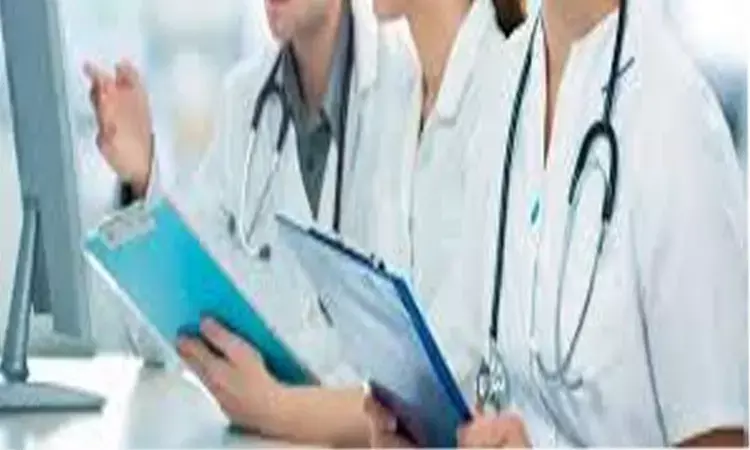- Home
- Medical news & Guidelines
- Anesthesiology
- Cardiology and CTVS
- Critical Care
- Dentistry
- Dermatology
- Diabetes and Endocrinology
- ENT
- Gastroenterology
- Medicine
- Nephrology
- Neurology
- Obstretics-Gynaecology
- Oncology
- Ophthalmology
- Orthopaedics
- Pediatrics-Neonatology
- Psychiatry
- Pulmonology
- Radiology
- Surgery
- Urology
- Laboratory Medicine
- Diet
- Nursing
- Paramedical
- Physiotherapy
- Health news
- Fact Check
- Bone Health Fact Check
- Brain Health Fact Check
- Cancer Related Fact Check
- Child Care Fact Check
- Dental and oral health fact check
- Diabetes and metabolic health fact check
- Diet and Nutrition Fact Check
- Eye and ENT Care Fact Check
- Fitness fact check
- Gut health fact check
- Heart health fact check
- Kidney health fact check
- Medical education fact check
- Men's health fact check
- Respiratory fact check
- Skin and hair care fact check
- Vaccine and Immunization fact check
- Women's health fact check
- AYUSH
- State News
- Andaman and Nicobar Islands
- Andhra Pradesh
- Arunachal Pradesh
- Assam
- Bihar
- Chandigarh
- Chattisgarh
- Dadra and Nagar Haveli
- Daman and Diu
- Delhi
- Goa
- Gujarat
- Haryana
- Himachal Pradesh
- Jammu & Kashmir
- Jharkhand
- Karnataka
- Kerala
- Ladakh
- Lakshadweep
- Madhya Pradesh
- Maharashtra
- Manipur
- Meghalaya
- Mizoram
- Nagaland
- Odisha
- Puducherry
- Punjab
- Rajasthan
- Sikkim
- Tamil Nadu
- Telangana
- Tripura
- Uttar Pradesh
- Uttrakhand
- West Bengal
- Medical Education
- Industry
55 percent increase in MBBS seats, 79 percent in PG medical seats in last 6 years: Health Ministry reviews progress

New Delhi: There has been an increase of 55.75% in the MBBS seats available across the country, in the last 6 years while there has been an increase of 79.77% in PG medical seats at the same time.
During the last six years, MBBS Seats increased by 30,301 (i.e. 55.75%) from 2014 (54,348 seats) to 2020 (84,649 seats) and the number of PG seats increased by 24,084 (i.e. 79.77%) from 2014 (30,191 seats) to 2020 (54,275 seats). Confirmation to this effect was recently made by a release by Union Health Ministry, in a document looking at the progress made in the last one year.
The document also noted that in the same period, 179 new medical colleges have been established and now the country has 562 (Govt: 286, Pvt: 276) medical colleges.
Under the Central Sponsored Scheme for the establishment of new medical colleges, the establishment of 157 medical colleges have been approved in three phases, of which 47 are functional and the remaining will be functional in few years. Of these 157 colleges, 39 are coming up in the Aspirational Districts of the country thereby addressing the issues of inequity in medical education.
To boost medical colleges in the country, the government this year moved towards the Rationalization of Minimum Standards Requirements (MSR).This will reduce the cost of establishment of new medical college and increase of intake capacity.
Besides this, in a major development this year, the government gave its nod to the two years post MBBS Diplomas by National Board of Examinations. Keeping in view the importance of Diploma courses to meet the shortfall of postgraduate students and augment healthcare in remote parts of the country, the National Board of Examinations (NBE) has launched diplomas in eight disciplines namely - Anaesthesia, Gynaecology & Obstetrics, Pediatrics, ENT, Opthalmology, Family Medicine, Tuberculosis & Chest Diseases and Medical Radiodiagnosis.
The year also saw the launch of District Residency Scheme for Post-Graduation. The MCI has also notified a Scheme known as District Residency Scheme for compulsory three months training of PG medical students at District Hospitals an essential component of postgraduate medical training curriculum. Under the Scheme, the second/third year PG students of medical colleges would be posted in the district hospitals for a period of three months.
The constitution of the National Medical Commission this year ushered in a landmark reform in the sector of Medical Education. On similar lines, the Government is striving to bring institutional reforms in the sector of nursing and dental education by passage of reformative legislations to replace the existing Indian Nursing Council Act, 1947, and Dentists Act, 1948. The Government is also in the process to address the long standing vacuum of a regulatory body for various professions included in the allied and healthcare sector by providing for a National Commission for Allied and Healthcare Professions, and a Bill to that extent has already been introduced in the Rajya Sabha. The basic premise and principled change that is happening in all these professional education sectors is that the Regulator is now being 'selected on merits', as opposed to an 'elected' regulator.
Meghna A Singhania is the founder and Editor-in-Chief at Medical Dialogues. An Economics graduate from Delhi University and a post graduate from London School of Economics and Political Science, her key research interest lies in health economics, and policy making in health and medical sector in the country. She is a member of the Association of Healthcare Journalists. She can be contacted at meghna@medicaldialogues.in. Contact no. 011-43720751


